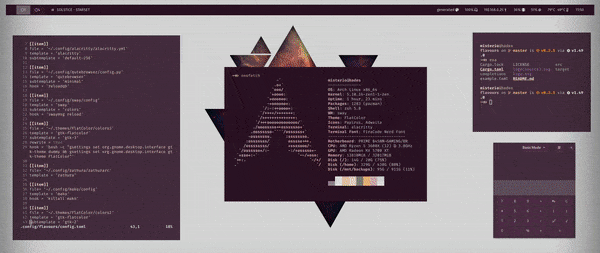A manager/builder for Base16. Written in Rust🦀.
This is a CLI program that both builds and manages Base16 schemes and templates.
The base16 specification consists of both schemes (with 16 colors) and templates. There'll probably be templates for most applications you use, but you can easily make one for literally any app that supports any sort of color customization.
Once your configuration files are set, you can theme your entire desktop with just one command. No more hassle changing themes when you get bored. Why have one color if you can have all the colors?
Here's how it looks in action (sway, waybar, alacritty):

yay -S flavoursnix-env -iA nixos.flavoursLet me know if you want to package flavours for your favorite distro.
Just install cargo and run cargo install flavours (don't forget to include ~/.cargo/bin on your PATH).
After installing, you should probably use flavours update all to grab all published schemes and templates from the base16 repos. If you want, you can manually tweak the templates, schemes or even the repo lists (everything's located in ~/.local/share/flavours on Linux, and can be changed with -d/--directory cli option or FLAVOURS_DATA_DIRECTORY environment variable).
You can use flavours and base16 templates to automatically inject schemes into any application config file that supports colors codes.
Dave Snider did a great 3 episode series about flavours (and theming in general). If you're into guide videos, i strongly recommend you take a look.
Choose a template for each app you want themed (or create your own).
On each of your apps config files, place a start and end comment to tell flavours where to replace lines (defaults are # Start flavours and # End flavours, can be changed individually on each app). These usually should be located where you set color options on your app configuration. If the specific app supports including colors from another file, or if the template provides the entire file, you can forgo the comments altogether and use the rewrite=true on flavours config.
For reference, here's a couple configuration files from my dots: - flavours itself - alacritty - qutebrowser - zathura - sway - waybar - rofi
On flavours configuration (~/.config/flavours/config.toml on Linux, can be changed with -c/--config flag or FLAVOURS_CONFIG_FILE environment variable):
- Optionally, set a shell through which your hook commands should be executed. Defaults to sh -c '{}'. You can make the hooks run directly (pre-0.4 behaviour) by setting it to just {}.
- Create a [[item]] section for each app, each section can have the following entries:
- Specify the file to write (required)
- A template (required)
- A hook to execute. Defaults to none.
- A subtemplate. Defaults to default.
- Specify whether the hook is considered (by your usage) to be light or not. flavours apply --light will skip running hooks marked with light=false. Defaults to true.
- Whether to use rewrite mode (if you do, you don't need the start and end comments). Defaults to false.
- Or change the start and end lines (useful for config files which comments are not started with #). Defaults to # Start flavours and # End flavours (case-insensitive).
Here's an example: ```toml
shell = "bash -c '{}'"
[[item]] file = "~/.config/sway/config" template = "sway" subtemplate = "colors" hook = "swaymsg reload"
light = false
[[item]] file = "~/.config/waybar/colors.css" template = "waybar"
rewrite = true
[[item]] file = "~/.config/beautifuldiscord/style.css" template = "styles" subtemplate = "css-variables"
start= "/* Start flavours /" end = "/ End flavours */" ```
Vóila. You're now ready to apply schemes.
flavours apply is the command you'll probably be using all the time. So it's built to be as useful as possible.
The syntax is flavours apply [PATTERN], where PATTERN can be a scheme name, multiple scheme name, a glob (such as *light) expression, or can be ommited.
If more than one scheme is specified or matched, flavours will choose one randomly (flavours apply *light will pick one random scheme ending with light, and apply it).
You can, for instance:
- Specify a scheme: flavours apply pasque
- Specify multiple schemes: flavours apply pasque paraiso atlas
- Use glob: flavours apply "gruvbox*"
- Omit: flavours apply (is the same as running flavours apply "*")
You can also use flavours current to see the last scheme you applied, flavours list to list all available schemes (you can also use PATTERN like on apply to list only specific scheme(s)), flavours info to show info (including truecolor colored output) about some scheme(s) (also supports the PATTERN syntax).
Lastly, we have flavours generate, it can generate a scheme based on an image (usually your wallpaper), with the following syntax: flavours generate <dark/light> /path/to/image/file. By default, the scheme will be saved with the slug (the scheme name referenced in all other commands) generated (you can change it with -s or --slug, or output to stdout instead with --stdout).
In my setup, i use swaybg to apply wallpapers, and i can get my current wallpaper with cat .bg.
So my flavours command to generate and apply a dark scheme matching my wallpaper would be:
flavours generate dark $(cat .bg) && flavours apply generated
Which i include in the script i use to change my wallpapers randomly.
Why use this instead of other base16 managers, or even pywal?
While these projects are great and certainly fit some people's workflow, they didn't quite fit mine.
I decided to do my own project because i wanted a simple CLI program that can easily integrate with rofi, polybar, and everything else in my workflow. The main feature is being able to quickly and easily use a curated list of schemes, on all your apps. It's also objectively faster than any other manager.
All features are implemented! I'm currently working on improving code quality and stabilizing the features, but everything should work as intended.